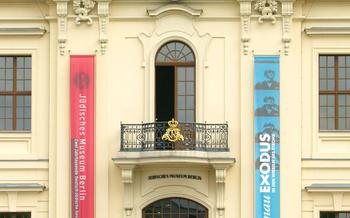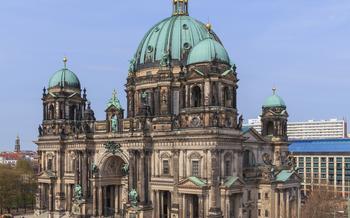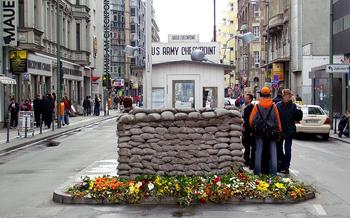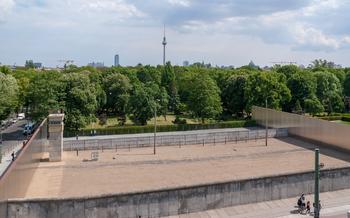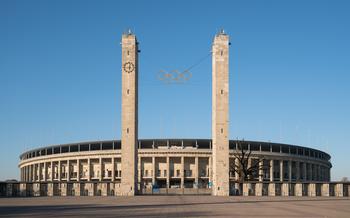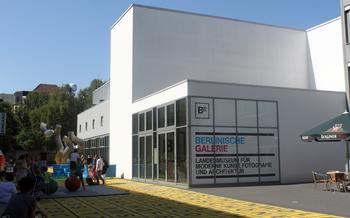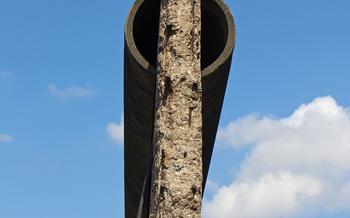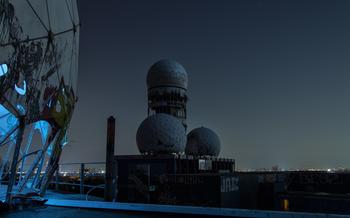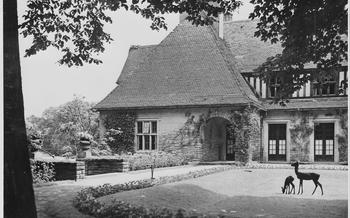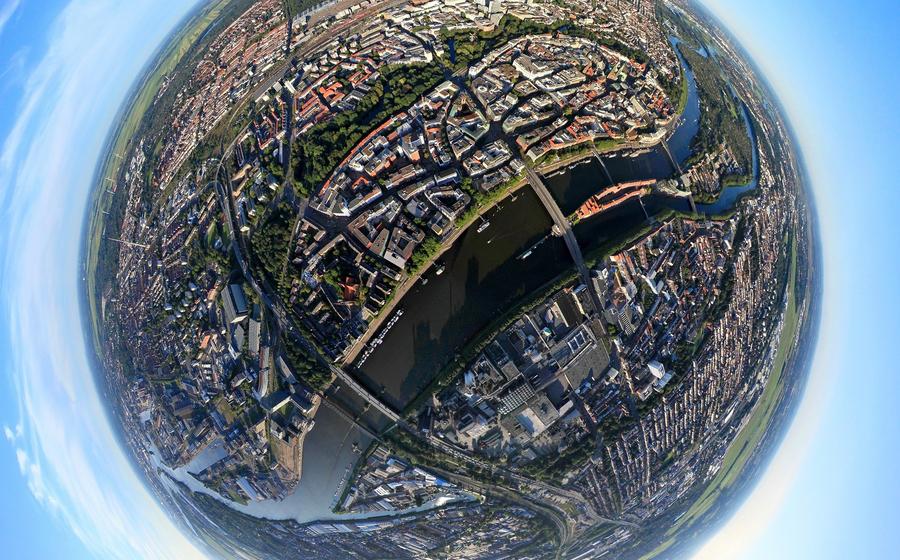
Lilienthal Aviation Museum
- Lilienthal Aviation Museum: A Monument to Aviation History
- Otto Lilienthal: The Father of Aviation
- Glider Hangar: Exploring Lilienthal's Aircraft
- Wind Tunnel Experiments: Unveiling the Secrets of Flight
- Otto Lilienthal Memorial: Paying Tribute to a Visionary
- Guided Tours: Exploring the Museum with Experts
- Family-Friendly Activities: Engaging Children in Aviation
- Museum Shop: Souvenirs and Aviation-Themed Gifts
- Accessibility and Facilities for Visitors
- Location and Transportation: Getting to the Lilienthal Aviation Museum
- Operating Hours and Admission Fees: Planning Your Visit
- Photography and Videography: Capturing Aviation Memories
- Research and Educational Resources: Unlocking Aviation Knowledge
- Insider Tip: Experiencing the Museum's Unique Charm
Lilienthal Aviation Museum: A Monument to Aviation History
The Lilienthal Aviation Museum in Anklam, Germany, stands as a testament to the pioneering spirit of Otto Lilienthal, widely regarded as the father of aviation. Established in 1997, the museum offers a comprehensive and immersive journey into the history of aviation, showcasing Lilienthal's significant contributions to the field of gliding and human flight.
Within its walls, visitors can delve into the life and work of Otto Lilienthal, exploring his early experiments with gliders, his meticulous wind tunnel studies, and his unwavering determination to conquer the skies. Through interactive exhibits, detailed replicas, and original artifacts, the museum brings to life the story of a visionary who laid the foundation for modern aviation.
Lilienthal's legacy extends beyond his groundbreaking achievements in aviation. As a pioneer in the field of aerodynamics, his work provided the groundwork for the development of airplanes and the eventual realization of powered flight. The Lilienthal Aviation Museum serves as a tribute to his tireless pursuit of knowledge and his enduring impact on the world of aviation.
Otto Lilienthal: The Father of Aviation
Otto Lilienthal, a German engineer, and aviation pioneer, is widely regarded as the "Father of Aviation" for his groundbreaking contributions to the field of gliding and human flight. Born in Anklam, Germany, in 1848, Lilienthal exhibited a passion for aviation from a young age. He conducted extensive research and experiments, studying the flight of birds and designing and building his own gliders.
With meticulous attention to aerodynamics and structural integrity, Lilienthal constructed a series of gliders, each representing an advancement in design and performance. His early gliders featured bat-like wings made of bamboo and fabric, allowing him to achieve controlled gliding flights over short distances. Over time, he refined his designs, incorporating innovations such as adjustable wings and tail surfaces for stability and maneuverability.
Lilienthal's experiments and achievements in gliding paved the way for the development of powered flight. His contributions were instrumental in demonstrating the feasibility of controlled, heavier-than-air flight, inspiring a generation of aviators and engineers to pursue their own dreams of soaring through the skies.
Lilienthal's dedication to aviation research and his pioneering spirit earned him international recognition and accolades. He published his findings in technical journals and books, sharing his knowledge and insights with the global aviation community. His work laid the foundation for the Wright brothers' successful powered flights, forever etching his name in the annals of aviation history.
Despite his tragic death in 1896 while testing one of his gliders, Lilienthal's legacy lives on. He is remembered as a visionary and a pioneer, whose unwavering pursuit of flight changed the course of aviation history. His contributions continue to inspire generations of aviators, engineers, and dreamers who dare to explore the boundless realm of the skies.
Glider Hangar: Exploring Lilienthal's Aircraft
In the Lilienthal Aviation Museum's Glider Hangar, visitors embark on a captivating journey through the evolution of glider design and construction techniques. Here, they encounter an impressive collection of original and replica gliders meticulously crafted by Otto Lilienthal, the pioneering father of aviation.
Each glider in the hangar is a testament to Lilienthal's ingenuity and relentless pursuit of flight. Detailed descriptions and explanations accompany each aircraft, providing insights into their unique features and significance in aviation history. From the early Normalsegelapparat, with its simple yet groundbreaking design, to the more advanced Doppeldecker, visitors can trace the progression of Lilienthal's designs as he strived to master the art of gliding.
The hangar also showcases the evolution of glider construction techniques. Visitors can observe the transition from traditional wooden frames and fabric coverings to the use of lightweight materials and innovative engineering solutions. These advancements not only improved the performance of Lilienthal's gliders but also laid the foundation for modern aircraft design.
By exploring the Glider Hangar, visitors gain a profound appreciation for Otto Lilienthal's contributions to aviation. His gliders, preserved and displayed with care, serve as a lasting legacy of his groundbreaking work and continue to inspire future generations of aviators and engineers.
Wind Tunnel Experiments: Unveiling the Secrets of Flight
Otto Lilienthal's contributions to aviation extended beyond his pioneering glider flights. He recognized the importance of scientific research and experimentation in understanding the principles of flight. Central to his investigations was the construction of a wind tunnel, a device that allowed him to study the aerodynamic forces acting on objects in a controlled environment.
Lilienthal's wind tunnel, built in 1891, was one of the first of its kind. It consisted of a long, enclosed tube with a fan at one end to generate airflow. Inside the tunnel, Lilienthal suspended models of his gliders and other objects to measure the lift, drag, and stability characteristics under different conditions.
Using his wind tunnel, Lilienthal conducted systematic experiments to analyze the effects of wing shape, angle of attack, and airspeed on the aerodynamic performance of his gliders. He painstakingly recorded and analyzed the data, making meticulous observations and calculations.
Through his wind tunnel experiments, Lilienthal gained valuable insights into the physics of flight. He discovered the importance of camber, or the curvature of the wing, in generating lift. He also investigated the effects of wingtip shape, aspect ratio, and the center of gravity on stability and control.
Lilienthal's wind tunnel experiments were groundbreaking for their time. His systematic approach and rigorous methodology set the stage for future aerodynamic research and laid the foundation for the development of modern aircraft. His contributions to wind tunnel technology and the understanding of aerodynamics remain significant to this day.
Otto Lilienthal Memorial: Paying Tribute to a Visionary
In the heart of Berlin, Germany, stands a poignant tribute to the father of aviation, Otto Lilienthal. The Otto Lilienthal Memorial, situated on Stubenrauchstraße near the bustling Tempelhofer Feld, serves as a testament to the pioneering spirit and enduring legacy of this remarkable man.
Crafted from bronze and granite, the memorial features a life-size statue of Lilienthal gracefully soaring through the air, his arms outstretched in a testament to his passion for flight. The sculpture captures the essence of his unwavering determination and the pivotal role he played in shaping the future of aviation.
Established in 1937, the memorial stands as a symbol of gratitude and respect for Lilienthal's groundbreaking achievements. The site was carefully chosen for its proximity to the former site of Lilienthal's gliding experiments, ensuring a deep connection to his historical endeavors.
The memorial not only commemorates Lilienthal's contributions to aviation but also serves as a poignant reminder of the risks and sacrifices that pioneers in any field must undertake in pursuit of their dreams. Lilienthal's tragic death in 1896 while conducting gliding experiments underscores the dangers inherent in pushing the boundaries of human flight.
Visitors to the memorial can pay their respects to this visionary figure and reflect on the profound impact he had on the world of aviation. The memorial stands as a lasting tribute to his indomitable spirit, his unwavering pursuit of knowledge, and his enduring legacy as the father of aviation.
Guided Tours: Exploring the Museum with Experts
Enrich your visit to the Lilienthal Aviation Museum by embarking on a guided tour, led by knowledgeable experts who bring the history of aviation to life. These tours, available in multiple languages, offer an immersive experience that delves deeper into the life and work of Otto Lilienthal, the museum's exhibits, and the significance of aviation's early pioneers.
With a guided tour, you'll gain unparalleled insights into the museum's collection of gliders, replicas, and artifacts. Your guide will provide fascinating anecdotes, technical explanations, and historical context, helping you understand the evolution of flight and the challenges faced by early aviators.
The museum's guides are passionate about aviation history and eager to share their knowledge with visitors. They'll point out hidden details, answer your questions, and provide a personalized experience tailored to your interests. Whether you're an aviation enthusiast, a history buff, or simply curious about the origins of flight, a guided tour is an excellent way to make the most of your visit.
Advance booking for guided tours is recommended, especially during peak seasons or for groups. Check the museum's website or contact the information desk for tour schedules, availability, and pricing.
Family-Friendly Activities: Engaging Children in Aviation
The Lilienthal Aviation Museum is not just a place for adults to delve into aviation history; it also offers an array of interactive exhibits and activities designed to capture the imagination of young visitors. Children of all ages can explore the wonders of flight through hands-on experiences, workshops, and educational games.
Interactive exhibits, such as flight simulators and wind tunnels, allow children to experience the thrill of flying and understand the principles of aerodynamics. They can build their own paper airplanes and test their designs in a dedicated wind tunnel, learning about factors like lift, drag, and stability.
The museum also organizes regular workshops and demonstrations, where children can engage with experts and gain insights into the science of aviation. These workshops cover topics such as glider construction, flight control, and the history of human flight.
Dedicated play areas and educational games provide a fun and interactive way for children to learn about aviation while developing their problem-solving skills and creativity. They can assemble model airplanes, solve aviation-themed puzzles, and participate in interactive quizzes.
By engaging children in hands-on activities and educational experiences, the Lilienthal Aviation Museum fosters a love for aviation and STEM subjects from an early age. These interactive elements make the museum an ideal destination for families looking to create memorable and educational experiences for their children.
Museum Shop: Souvenirs and Aviation-Themed Gifts
The Lilienthal Aviation Museum gift shop is a treasure trove for aviation enthusiasts, offering a wide range of souvenirs, books, and aviation-related merchandise. From unique gifts to memorabilia, visitors can find something special to commemorate their visit or share with fellow aviation buffs.
The shop boasts an impressive collection of aviation-themed souvenirs, including model airplanes, keychains, postcards, and posters. Visitors can also find books and publications on aviation history, biographies of famous aviators, and technical manuals.
Proceeds from the museum shop directly support the museum's preservation and educational efforts, ensuring that the legacy of Otto Lilienthal and the history of aviation continue to be shared with future generations.
In addition to the on-site shop, the museum also offers an online shop, providing worldwide access to its unique collection of aviation-themed merchandise. Whether you're a passionate aviation enthusiast or simply looking for a special gift, the Lilienthal Aviation Museum's gift shop is sure to have something for everyone.
Accessibility and Facilities for Visitors
The Lilienthal Aviation Museum is committed to providing an accessible and welcoming environment for all visitors, regardless of their abilities or needs. The museum offers a range of accessibility features to ensure that everyone can enjoy and learn from its exhibits and programs.
Wheelchair Accessibility: The museum is wheelchair accessible, with ramps and elevators providing access to all levels of the building. Wide doorways and aisles allow for easy maneuverability throughout the exhibits.
Restrooms: Accessible restrooms are available on each floor of the museum, equipped with grab bars, accessible sinks, and ample space for maneuvering.
Parking: Designated accessible parking spaces are available in the museum's parking lot, located close to the main entrance.
Visitor Information: The museum provides visitor information in accessible formats, including large print, Braille, and audio guides. Staff members are also available to assist visitors with disabilities in finding their way around the museum and accessing its exhibits.
Accommodations for Visitors with Limited Mobility: Visitors with limited mobility can request assistance from museum staff to navigate the exhibits. Wheelchairs and mobility scooters are available for use on a first-come, first-served basis.
Sensory Considerations: The museum understands that some visitors may have sensory sensitivities. Quiet areas are available for those who need a break from the hustle and bustle of the museum. Staff members are also trained to assist visitors with sensory sensitivities.
By providing these accessibility features and accommodations, the Lilienthal Aviation Museum strives to create an inclusive and enjoyable experience for all visitors.
Location and Transportation: Getting to the Lilienthal Aviation Museum
The Lilienthal Aviation Museum is conveniently located at Hermann-Köhl-Straße 12, 27751 Delmenhorst, Germany. Reaching the museum is a breeze, whether you prefer public transportation or private vehicles.
Public Transportation:
For those relying on public transportation, the museum is well-connected by bus routes. Bus lines 201, 202, and 203 stop right outside the museum, making it easily accessible from various parts of the city.
Driving Directions:
If you're traveling by car, simply follow these directions:
- Take the A28 Autobahn and exit at Delmenhorst-Deichhorst.
- Follow the signs for Delmenhorst-Mitte.
- Turn left onto Hermann-Köhl-Straße.
- The museum will be on your right-hand side.
Parking:
Ample parking spaces are available on-site for visitors arriving by car. The parking lot is free of charge, making it convenient for those who prefer to drive to the museum.
Integration with Other Attractions:
The Lilienthal Aviation Museum is situated in close proximity to other notable attractions in the area. Visitors can easily combine their visit to the museum with exploring the nearby attractions, creating a well-rounded and enjoyable itinerary.
- Bremen Airport: Just a short distance away, the Bremen Airport offers a glimpse into modern aviation and is a great place to observe aircraft taking off and landing.
- Graftanlagen Park: This beautiful park, located near the museum, provides a tranquil oasis for relaxation and a chance to enjoy nature's beauty.
- Delmenhorst Castle: A historic castle with a rich history, Delmenhorst Castle is a must-visit for those interested in exploring the region's cultural heritage.
Operating Hours and Admission Fees: Planning Your Visit
The Lilienthal Aviation Museum welcomes visitors on a regular schedule, providing ample opportunities to explore the wonders of aviation history. To plan your visit effectively, it's essential to be aware of the museum's operating hours and admission fees.
The museum is open to the public from Tuesday to Sunday, with specific hours for each day. On weekdays, it operates from 10:00 AM to 5:00 PM, allowing visitors to delve into the exhibits during standard working hours. On weekends, the museum extends its hours from 11:00 AM to 6:00 PM, catering to those who prefer a more leisurely visit.
Admission fees are structured to ensure accessibility and affordability for all visitors. Adults can gain entry for a reasonable fee, while children and students benefit from discounted rates. Family tickets offer a cost-effective option for families with multiple members wishing to explore the museum together.
To enhance your visit and avoid queues, consider purchasing advance tickets online. The museum's website provides a convenient platform for online reservations, allowing you to secure your spot and skip the lines.
When planning your visit, keep in mind the museum's peak and off-peak seasons. During the summer months, particularly July and August, the museum experiences a surge in visitors due to the influx of tourists. If you seek a quieter and more intimate experience, consider visiting during the shoulder seasons (spring and autumn) or on weekdays.
By being informed about the Lilienthal Aviation Museum's operating hours and admission fees, you can plan a seamless and enjoyable visit, immersing yourself in the history of aviation without any hassles.
Photography and Videography: Capturing Aviation Memories
The Lilienthal Aviation Museum encourages visitors to capture their experiences through photography and videography. Designated areas within the museum allow visitors to take pictures and record videos, preserving their memories of this historic site. However, it is important to respect the privacy of other visitors and museum staff while doing so.
When taking photographs or videos, please be mindful of the following guidelines:
-
Flash photography is not permitted to avoid disturbing other visitors and damaging delicate artifacts.
-
Tripods and other photography equipment should be used with caution to ensure the safety of visitors and exhibits.
-
Drones and other flying devices are not allowed within the museum or its vicinity for safety reasons.
-
Commercial photography and videography require prior permission from the museum administration.
By following these guidelines, visitors can contribute to the preservation of the museum's unique collection while capturing their own aviation memories. Sharing these experiences through social media platforms can help spread the word about the museum and its mission to educate and inspire future generations.
Research and Educational Resources: Unlocking Aviation Knowledge
The Lilienthal Aviation Museum is not just a place to admire historical artifacts; it is also a hub for aviation research and education. The museum houses an extensive library, archive, and research facilities that are accessible to students, researchers, and aviation enthusiasts. These resources include a vast collection of books, journals, photographs, and documents related to the history of aviation, with a particular focus on the life and work of Otto Lilienthal.
The museum collaborates with universities and institutions worldwide to facilitate academic projects, research initiatives, and educational programs. These partnerships provide students and researchers with the opportunity to access unique resources, conduct in-depth studies, and contribute to the understanding of aviation history. Through these collaborations, the museum actively promotes the study and advancement of aviation knowledge.
Whether you are a student, researcher, or simply passionate about aviation history, the Lilienthal Aviation Museum offers a wealth of resources and opportunities to deepen your understanding of this fascinating field. Explore the museum's library and archives, engage with knowledgeable staff, and immerse yourself in the rich history of aviation.
Insider Tip: Experiencing the Museum's Unique Charm
To truly immerse yourself in the captivating world of aviation history at the Lilienthal Aviation Museum, consider visiting during the early morning hours or late afternoon, when the crowds are smaller, allowing for a more intimate and personalized experience. Engage with the knowledgeable museum staff and volunteers who are passionate about sharing their insights, stories, and anecdotes about Otto Lilienthal and the history of aviation. Combine your museum visit with a stroll through the picturesque surrounding park, where you can reflect on the legacy of this visionary pioneer while enjoying the tranquil natural beauty. Dress comfortably and respectfully, as the museum is a place of historical significance and reverence for the contributions of Otto Lilienthal to the field of aviation.
